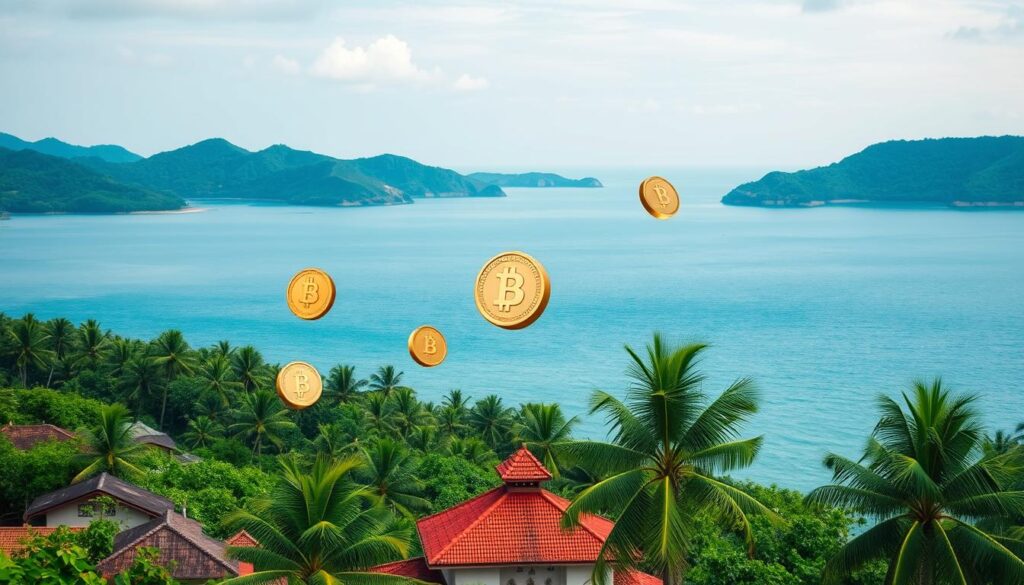IMF Reports Sri Lanka’s Economy Gradually Improving
As the global economy faces tough challenges, Sri Lanka shows real signs of betterment. The International Monetary Fund (IMF) sees improvement in the Sri Lanka economy. They point to strong reforms and good financial policies. The IMF expects growth to reach 4.4% by 2024. This reflects the country’s hard work to stabilize and advance after past struggles.
Recent reports talk about lowered inflation, a stronger currency, and better financial reserves. These changes help the economy grow in late 2023. After declaring bankruptcy in April 2022, Sri Lanka worked hard to recover. Its debt was over $83 billion. With the IMF’s help, Sri Lanka is now on a path to recovery, thanks to tough budget cuts and changes.
According to the IMF statement, these changes show a move towards more open and stable government. Sri Lanka is making smart money moves. It’s becoming a strong player in the global economy again. Recent Sri Lanka news says the IMF’s help is key to creating a stable, prosperous future.
Commitment to reform is leading Sri Lanka to recovery. This gives its people hope. OMP Sri Lanka aims to give up-to-date, accurate info on these changes. They want to provide the latest news to those who want official updates.
Economic Indicators Show Signs of Stability
Lately, reports bring good news about economic stability in Sri Lanka. They highlight key economic indicators. These indicators show that Sri Lanka’s economy is healing. After some tough times, signs of economic progress can now be seen. This suggests that Sri Lanka’s economy is getting better step by step.
Decrease in Inflation from Peak Levels
In a major move, Sri Lanka has cut its inflation. It went from a high of 70% last year to just 5.9% now. This big drop shows that the country’s financial plans are working well. It also means better chances for Sri Lanka’s GDP growth and more trust from investors.
Gross Domestic Product (GDP) Growth in Recent Quarters
The national GDP is showing growth. It went up by 1.6% in the third quarter and then by 4.5% in the last quarter of 2023. These numbers point to an improving economy that is healing well from past downfalls.
Stabilization of Sri Lanka’s Currency and Interest Rates
The country’s currency is now stable and interest rates are steady at 10%. This is a big improvement for Sri Lanka’s financial health. President Ranil Wickremesinghe, who took office in July 2022, has played a key role in these changes. Adjustments to interest rates are part of efforts to keep financial stability and draw in foreign money.
| Economic Indicator | 2023 | 2024 Projections |
|---|---|---|
| GDP Growth Rate | 1.6% Q3; 4.5% Q4 | 2.2% |
| Inflation Rate | 5.9% | Stable |
| Interest Rates | 10% | Stabilized |

Reforms in Sri Lanka’s financial and economic sectors are supported by solid IMF reports. They show how Sri Lanka’s economy is adapting to the global economy. Despite hard times, these recovery steps are promising for the future of the nation.
IMF’s Extended Fund Facility and Economic Reform Agenda
Sri Lanka’s Economy Gradually Improving is a goal that the International Monetary Fund (IMF) aims to foster through its support via the Extended Fund Facility (EFF). The IMF’s EFF offers not just money, but also ways to make big economic changes. After the second review under the EFF, the IMF gave Sri Lanka another $336 million.
This step brought the total help to about $1 billion, showing strong support for Sri Lanka. The country is working hard on reforming and rearranging its debts. More than 25% of Sri Lankans are battling poverty. Yet, there’s hope with a predicted 2% growth in 2024.
The rise of foreign exchange reserves to $5.5 billion shows promise. This boost helps the country confidently manage important imports. This is a sign of recovering economic health. But, careful and steady policies are key, especially with elections ahead. These events might risk the IMF’s EFF and recovery plans.
Sri Lanka should focus on passing new laws for its Central Bank. This means making the bank’s independence a key part of managing the economy. Past mistakes in economic management highlight the need for agreement and steady big-picture plans. These should be backed by laws that push for clear budgeting and prevent risky loans.
Setting clear economic policies is crucial. They should avoid risky borrowing abroad. This approach is vital for moving away from financial crises towards growth and fair development.
IMF’s Extended Fund Facility and Economic Reform Agenda
What recent report has IMF provided on Sri Lanka’s economy?
The International Monetary Fund reports Sri Lanka’s economy is getting better. This improvement is seen in lower inflation and GDP growth. These signs point to economic stability.
What are the current inflation levels and GDP growth rates in Sri Lanka?
Inflation in Sri Lanka has dropped from a high of 70 percent in 2022 to 5.9 percent now. The GDP grew by 1.6 percent in the third quarter. It then increased to 4.5 percent in the fourth quarter of 2023. This shows the economy is recovering.
How has the Sri Lankan currency and interest rates stabilized?
Since President Ranil Wickremesinghe took office, his policies have helped stabilize the country’s currency. Interest rates have also been reduced to about 10 percent. These steps are helping Sri Lanka’s economic recovery.
What does the decrease in Sri Lanka’s inflation signify?
The fall in inflation indicates Sri Lanka is moving towards economic stability. It creates a better environment for growth and boosts market confidence.
How significant is the recent GDP growth in Sri Lanka’s economy?
The recent GDP growth is very important. It marks a recovery from earlier declines and shows the economy is improving.
What impact has the stabilization of Sri Lanka’s currency and interest rates had on the economy?
Stabilizing the currency and lowering interest rates have made essentials like food and medicine more available. Electricity has been restored. These steps are crucial for Sri Lanka’s stability and growth.
What is the role of IMF’s Extended Fund Facility in Sri Lanka’s economic recovery?
The IMF’s Extended Fund Facility is key to Sri Lanka’s recovery. It provides funds and advice for reforms, supports engagement with creditors, and aims for stable and inclusive growth.
How much has Sri Lanka accessed from the IMF under the Extended Fund Facility program?
Sri Lanka has gotten about 7 million from the IMF after its second review of the EFF. So far, the country has received a total of about
IMF’s Extended Fund Facility and Economic Reform Agenda
What recent report has IMF provided on Sri Lanka’s economy?
The International Monetary Fund reports Sri Lanka’s economy is getting better. This improvement is seen in lower inflation and GDP growth. These signs point to economic stability.
What are the current inflation levels and GDP growth rates in Sri Lanka?
Inflation in Sri Lanka has dropped from a high of 70 percent in 2022 to 5.9 percent now. The GDP grew by 1.6 percent in the third quarter. It then increased to 4.5 percent in the fourth quarter of 2023. This shows the economy is recovering.
How has the Sri Lankan currency and interest rates stabilized?
Since President Ranil Wickremesinghe took office, his policies have helped stabilize the country’s currency. Interest rates have also been reduced to about 10 percent. These steps are helping Sri Lanka’s economic recovery.
What does the decrease in Sri Lanka’s inflation signify?
The fall in inflation indicates Sri Lanka is moving towards economic stability. It creates a better environment for growth and boosts market confidence.
How significant is the recent GDP growth in Sri Lanka’s economy?
The recent GDP growth is very important. It marks a recovery from earlier declines and shows the economy is improving.
What impact has the stabilization of Sri Lanka’s currency and interest rates had on the economy?
Stabilizing the currency and lowering interest rates have made essentials like food and medicine more available. Electricity has been restored. These steps are crucial for Sri Lanka’s stability and growth.
What is the role of IMF’s Extended Fund Facility in Sri Lanka’s economic recovery?
The IMF’s Extended Fund Facility is key to Sri Lanka’s recovery. It provides funds and advice for reforms, supports engagement with creditors, and aims for stable and inclusive growth.
How much has Sri Lanka accessed from the IMF under the Extended Fund Facility program?
Sri Lanka has gotten about $337 million from the IMF after its second review of the EFF. So far, the country has received a total of about $1 billion from the program.
What does the IMF’s agreement on Sri Lanka’s economic reform agenda entail?
The IMF’s agreement with Sri Lanka includes policy reforms for debt restructuring and fiscal policy improvements. It supports economic stability and growth.
billion from the program.
What does the IMF’s agreement on Sri Lanka’s economic reform agenda entail?
The IMF’s agreement with Sri Lanka includes policy reforms for debt restructuring and fiscal policy improvements. It supports economic stability and growth.



